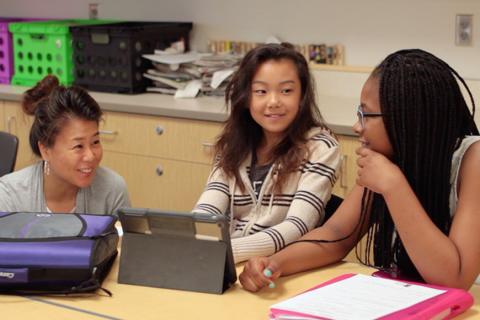
Listening to Youth

Kari Smalkoski, a researcher in the University of Minnesota’s Department of Gender, Women and Sexuality Studies (GWSS), was working on her dissertation when Heidi Barajas, her graduate school mentor and current executive director of the Robert J. Jones Urban Research and Outreach-Engagement Center (UROC), told her to “Do work where you have the most impact.”
At the time, Smalkoski didn’t understand what Barajas meant, but instinctively believed that the message was important and would guide her throughout her doctoral work. Smalkoski, whose scholarship focuses on masculinity and boyhood, studied the experiences of Hmong youth being bussed from their North Minneapolis neighborhoods to predominately white suburban schools with their African American peers.
Over three years, she found that the Hmong boys experienced high levels of bullying and social isolation, but also resilience and educational advancement due in part to male mentors who never gave up on them.
“Every single boy in my study had experienced bullying, physical violence and/or social isolation,” she recalls, adding that most of them didn’t talk about what they were going through with anyone. “They have so many stories to tell, but people aren’t listening. Most adults have already made up their minds about these boys so they’re not on anyone’s radar.”
That’s why Smalkoski, a member of UROC’s Executive Advisory Committee, is now committed to working with youth to tell their stories. Along with co-leader Jigna Desai, a professor of gender, women and sexuality studies at the University, she conducted a successful pilot project last year at St. Paul’s Parkway Montessori and Community Middle School. (Watch a video about the project here: https://vimeo.com/168947511.)
A partnership between GWSS, St. Paul Public Schools and UROC, the project was supported by the College of Liberal Arts. In 2016, all 500 Parkway students created digital stories about social issues affecting their in and out of school. And a team of undergraduate and graduate students, led by Smalkoski and Desai, worked with the kids each week.
“Tim Hofmann, Parkway’s founding principal understood from the beginning that the videos were a tool to hook youth and engage them in school while tapping into their social emotional learning,” Smalkoski says. Pairing the students with University undergrads and graduate students also helped, she believes, because it helped the youth see a pathway to college for themselves.
Several of the kids’ digital stories were presented at Northrop Auditorium to University President Eric Kaler, College of Liberal Arts Dean John Coleman and former Minneapolis Mayor R.T. Rybak when the project wrapped up in May. “We left the topics really open and asked the kids to think about issues that are important in their lives, and what they talked about was amazing,” Smalkoski recalls, explaining that some of the topics covered were racism, gun violence, environmental issues, poverty, homelessness, gender identity and women’s issues.
Now, she and Desai are working on phase two of the project, known as 10,000 Digital Stories: Minnesota Youth Make Media, which will focus on Parkway and another middle school that serves students from North Minneapolis. “Our evaluation told us we are on the right track and we realized that there are so many things happening beyond what we set out to accomplish,” she says. “Kids are starting to talk to one another more and open more, teachers are talking about their classroom practices and there has been impactful peer relationship building. But there’s still so much work to do.”
In addition to digital storytelling, students participating in phase two will be able to tell their stories using photography and perhaps also music and art. “A lot of students really connected with the videos and others didn’t so we want to offer other ways for them to tell their stories,” she says. “What we want to do is show how, as adults it’s easy to forget what’s useful for kids but if we can engage them by helping them connect their lives with ethnic studies, history and other things, that’s a pathway to get them engaged in math, reading and everything else.”